Search results for: 'bronzezeit'
-
 Mycenaean pottery stirrup jar
Mycenaean pottery stirrup jarCharacteristic type of vessel for the Mycenaean civilization in Bronze Age Greece. From the peak of Mycenaean pottery production in the 14th century BC.
Price: on request Small storage vessel from Early Bronze Age
Small storage vessel from Early Bronze AgeThe elegant vessel could be stringed and suspended to protect its content from animals. From Early Bronze Age Europe.
Price: on request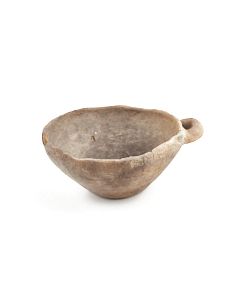 Bronze Age bowl with handle
Bronze Age bowl with handleThe simple dish is made of coarse clay and originated in Bronze Age Europe.
Price: on request Cult vessel of the Yortan culture
Cult vessel of the Yortan cultureWonderful double vessel with incised decoration. From the Early Bronze Age of Western Anatolia.
Price: on request Egyptian scarab with cross design
Egyptian scarab with cross designAmulet seal with complex design of crosses on the underside. Second Intermediate Period of ancient Egypt.
Price: on request Egyptian wooden statuette
Egyptian wooden statuetteFigure painted in black and red from the 12th dynasty of ancient Egypt. Probably part of a larger wooden model for a tomb.
Price: on request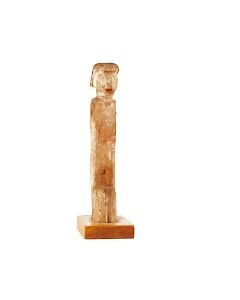 Egyptian wooden statuette
Egyptian wooden statuetteFigure painted in black and red from the 12th dynasty of ancient Egypt. Probably part of a larger wooden model for a tomb.
Price: on request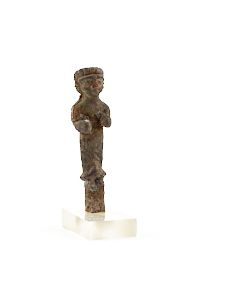 Canaanite bronze figurine
Canaanite bronze figurineThe small figure was once silver plated and was made in biblical times in the Land of Canaan. It might depict a charioteer.
Price: on request Scarab with cross design
Scarab with cross designAmulet seal with complex design of crosses on the underside. Second Intermediate Period of ancient Egypt.
Price: on request Egyptian button seal
Egyptian button sealAmulet seal as a good luck charm with a protective function. Second Intermediate Period of ancient Egypt.
Price: on request Egyptian scarab with interesting stamp design
Egyptian scarab with interesting stamp designAmulet seal with a complex knot design on the underside, possibly symbolizing the unity of Egypt. Second Intermediate Period of ancient Egypt.
Price: on request Clay tablet with cuneiform text
Clay tablet with cuneiform textSmall cuneiform writing tablet with well preserved text on both sides.
Price: on request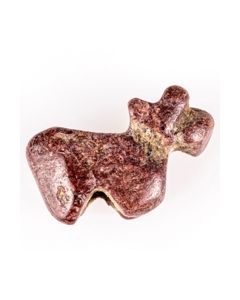 Sumerian miniature ram amulet
Sumerian miniature ram amuletNice small stone amulet in the stylized shape of a ram. From the 3rd Millenium BC.
Price: on request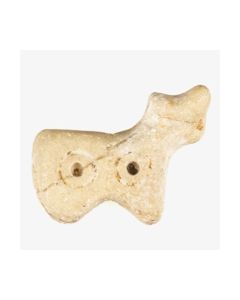 Sumerian ram amulet
Sumerian ram amuletNice small stone amulet in the stylized shape of a ram. From the 3rd Millenium BC.
Price: on request Egyptian scarab with knot design
Egyptian scarab with knot designAmulet seal with a complex knot design on the underside, possibly symbolizing the unity of Egypt. Second Intermediate Period of ancient Egypt.
Price: on request Sumerian miniature ram amulet
Sumerian miniature ram amuletNice small stone amulet in the stylized shape of a ram. From the 3rd Millenium BC.
Price: on request Egyptian Kohl vessel
Egyptian Kohl vesselThe small stone pot of nicely polished granite was used for Kohl, the eye cosmetic of the ancient Egyptians. From the time between Middle Kingdom and New Kingdom.
Price: on request Egyptian scarab
Egyptian scarabAmulet seal in the shape of a scarab with schematic top side and braided tape on the underside. Second Intermediate Period of ancient Egypt.
Price: on request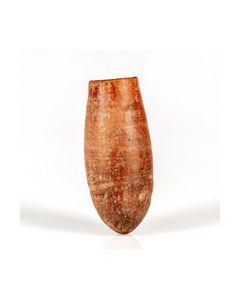 Egyptian predynastic redware jar
Egyptian predynastic redware jarSimple pottery vessel of timeless elegance. From the Naqada I period, 4th Millenium BC.
Price: on request Egyptian scarab with spiral design
Egyptian scarab with spiral designAmulet seal in the shape of a scarab with schematic top side. Second Intermediate Period of ancient Egypt.
Price: on request Early flat axe from Judea
Early flat axe from JudeaInteresting bronze axe head from Early Bronze Age. The piece was found in Judea.
Price: on request Early flat axe from Judea
Early flat axe from JudeaCompact bronze axe head from Early Bronze Age. The piece was found in Judea.
Price: on request Syrian amulet in animal shape
Syrian amulet in animal shapeSmall amulet of nice red stone in the stylized shape of a pig. From the 3rd Millenium BC.
Price: on request Egyptian hippopotamus amulet
Egyptian hippopotamus amuletMade in the style of a scarab but with a hippopotamus on the upper side. It was a protective amulet during the 18th or 19th dynasty of Ancient Egypt. It might have protected a pregnant woman. The amulet comes from the famous Matouk collection and is published in his 1971 book.
Price: on request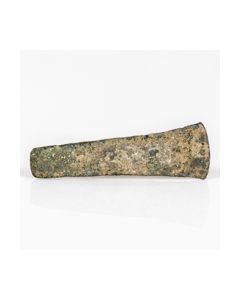 Early flat axe from Judea
Early flat axe from JudeaTrapezoidal axe head from Early Bronze Age. The piece was found in Judea.
Price: on request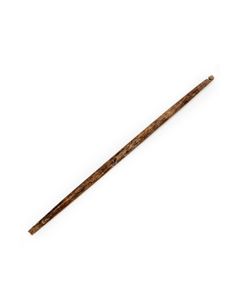 Egyptian spindle shaft made of wood
Egyptian spindle shaft made of woodExceptionally rare main piece of a hand spindle. A find from Thebes in Upper Egypt. From the reign of pharao Senusret II, around 1840 BC.
Price: on request Two Mesopotamian mosaic cones
Two Mesopotamian mosaic conesThe pieces were part of a mosaic decoration of a Mesopotamian structure in the 4th Millenium BC. The temple architecture from Uruk is a particularly well known example of such a use.
Price: on request Sumerian foundation cone from Uruk
Sumerian foundation cone from UrukSmall conoid clay nail with cuneiform inscription. From the main temple of Uruk, that is also mentioned in the Epos of Gilgamesh. Circa 3rd Millenium BC.
Price: on request Mesopotamian cuneiform tablet
Mesopotamian cuneiform tabletSmall clay tablet with well preserved Sumerian cuneiform writing. From Mesopotamia, probably from Uruk.
Price: on request Clay ushabti
Clay ushabtiTall Egyptian funerary statuette from the New Kingdom. From the collection of the archaeologist and artist Erich Charlier.
Price: on request Canaanite bronze blade from General Moshe Dayan collection
Canaanite bronze blade from General Moshe Dayan collectionHoly Land, 3rd - 2nd millennium BC. Exhibited in the Jewish Museum in New York City in 1975. Moshe Dayan was a famous Israeli politician and military leader who served as Chief of Staff of the Israeli Defense Forces, personally commanded the Israeli forces during the 1956 Suez Crisis and served as Defense Minister.
Price: on request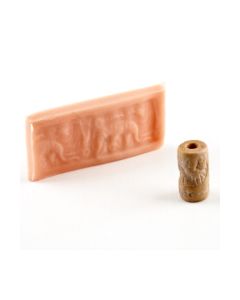 Cylinder seal from early dynastic Mesopotamia
Cylinder seal from early dynastic MesopotamiaDas frühdynastische Rollsiegel aus Mesopotamien zeigt eine Szene mit zwei Personen im Boot, eine davor stehende mit Stab. Es ist aus schönem karamellfarbenem Stein geschnitten. Mitte 3. Jt. v. Chr.
Price: on request Late Bronze age cylinder seal
Late Bronze age cylinder sealLevantinisches Zylindersiegel aus schwarzem Stein. 2. Jt. v. Chr., vermutlich Spätbronzezeit. 16mm lang.
Price: on request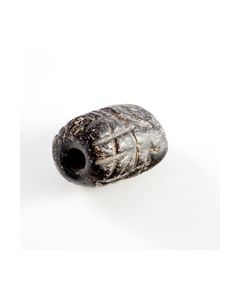 Levantine calinder seal
Levantine calinder sealVorderasiatisches Zylindersiegel aus schwarzem Stein mit geometrischem Motiv. Ca. 17mm lang. Spätbronzezeit.
Price: on request Early bronze age mesopotamian cylinder seal
Early bronze age mesopotamian cylinder sealDas vermutlich sumerische Rollsiegel aus schönem schwarzen Stein trägt ein geometrisches Muster als Motiv. Es stammt aus der Uruk- bis Djemdet Nasr-Zeit, 4. bis frühes 3. Jt. v. Chr.
Price: on request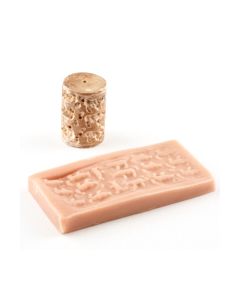 Sumerisches Rollsiegel - Segen der Herden
Sumerisches Rollsiegel - Segen der HerdenSzene mit Herde in Stallung, vermutlich Darstellung göttlichen Segens. Ein Vergleichsfund aus Farah befindet sich im Vorderasiatischen Museum Berlin. 4. bis frühes 3. Jt. v. Chr.
Price: on request

